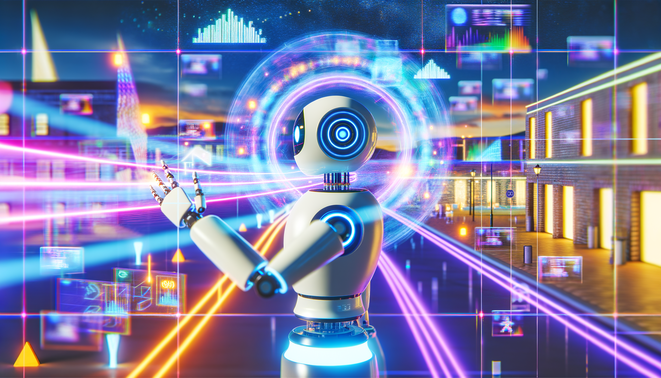Introduction to AI Agents
AI agents are intelligent systems designed to perform tasks autonomously by leveraging data, algorithms, and machine learning. Their significance stems from their capability to automate processes, enhance decision-making, and improve operational efficiency across various sectors. In industries such as healthcare, finance, and customer service, AI agents analyze large datasets to provide insights, streamline workflows, and facilitate enhanced customer interactions. For instance, AI chatbots in customer support can address inquiries 24/7, reducing response times and freeing human agents to focus on complex issues [Source: Construction Dive].
The impact of AI agents extends beyond mere convenience; they are pivotal in optimizing resource allocation and honing strategic initiatives. In healthcare, AI algorithms assist in diagnosing diseases faster than human counterparts, subsequently improving patient outcomes through timely interventions. Similarly, in finance, AI systems are employed for predictive analytics, risk assessment, and fraud detection, significantly reducing financial losses and enhancing regulatory compliance [Source: Nature]. As industries continue to embrace AI technologies, the potential for innovation and efficiency increases, positioning firms to respond nimbly to market changes and customer needs. For more insights into how AI is transforming workflows, check out our article on AI-driven workflows.
Types of AI Agents
AI agents are broadly classified into three categories: rule-based agents, learning agents, and multi-agent systems, each serving distinct functions in artificial intelligence applications.
- Rule-Based Agents: These agents operate based on a set of predetermined rules and conditions. They utilize “if-then” statements to make decisions, which means they require a structured environment where all possible scenarios can be defined in advance. Rule-based agents are commonly employed in expert systems, for instance, medical diagnosis tools that follow protocols for diagnosis based on patient symptoms. A notable example is MYCIN, an early expert system designed for identifying bacterial infections and recommending antibiotics based on rules derived from medical knowledge [Source: ScienceDirect].
- Learning Agents: In contrast to rule-based agents, learning agents improve their performance over time by learning from their experiences. They adapt to new situations and can recognize patterns through data input, which allows them to make predictions or decisions in unpredictable environments. Learning agents are prominent in machine learning applications, such as recommendation systems on platforms like Netflix or Amazon, where algorithms analyze user behavior to suggest relevant content or products. Deep learning frameworks, including neural networks, exemplify this category by processing large datasets to improve prediction accuracy [Source: Towards Data Science].
- Multi-Agent Systems (MAS): These are composed of multiple interacting agents that can be either rule-based or learning agents. Multi-agent systems are designed to solve problems that are difficult for a single agent to handle. They facilitate collaboration and coordination among agents to achieve a common goal, such as in traffic management systems where various agents monitor and control traffic flow. Applications extend to robotics, where multi-agent systems coordinate autonomous vehicles for tasks such as mapping and exploration [Source: Springer].
Together, these classifications of AI agents highlight the diverse methodologies employed in artificial intelligence, each suited to different types of tasks and environments, ultimately contributing to the advancement of automated systems across various fields. For further insights on specific applications of AI agents, you can explore AI in Recruitment and Understanding AI Automation.
How AI Agents Work
AI agents operate by leveraging advanced technologies and algorithms that enable them to interact with users and perform complex tasks autonomously. The backbone of these AI agents typically includes machine learning, natural language processing (NLP), and sophisticated decision-making capabilities.
- Machine Learning: This subset of artificial intelligence allows AI agents to learn from data and improve their performance over time without explicit programming. It includes various algorithms such as supervised learning, unsupervised learning, and reinforcement learning, each applied for different functionalities like classification, regression, and clustering. For instance, AI agents can manage customer service inquiries by analyzing past interactions to predict the best responses. This method enhances the personalization of services, improving user satisfaction [Source: Nature].
- Natural Language Processing (NLP): NLP plays a critical role in facilitating interactions between users and AI agents. NLP algorithms enable these agents to understand, interpret, and respond to human language effectively. Techniques such as tokenization, named entity recognition, and sentiment analysis allow AI systems to process conversational inputs and generate coherent and contextually relevant outputs. This capability not only enriches user engagement but also automates various tasks like content generation and information retrieval, making them more efficient [Source: Nature].
- Decision-Making Algorithms: AI agents utilize advanced decision-making algorithms to evaluate scenarios and choose the optimal course of action based on learned experiences and data analysis. These algorithms can range from simple rule-based systems to more complex models such as decision trees and neural networks. They are essential in applications like autonomous vehicles, where AI must make split-second decisions based on real-time sensory data. The ongoing refinement of these algorithms is crucial for enhancing the reliability and accuracy of AI systems in dynamic environments [Source: Nature].
In sum, the integration of machine learning, NLP, and decision-making algorithms forms the core functionality of AI agents, enabling them to perform tasks with an increasing degree of sophistication, making them indispensable tools across various sectors.
Applications of AI Agents
AI agents are transforming various sectors by automating tasks, analyzing data, and enhancing decision-making processes. In healthcare, AI is applied in predictive analytics, aiding in early diagnosis and personalized treatment plans. For instance, machine learning algorithms can analyze patient data to predict outcomes and tailor health interventions, significantly improving patient care [Source: NCBI].
In finance, AI agents optimize trading strategies and risk management. They analyze vast datasets to detect market trends and automate trading processes, increasing efficiency and profitability. Financial institutions leverage AI to personalize banking experiences through chatbots that offer real-time assistance, enhancing customer satisfaction [Source: IBM].
In customer service, AI agents such as chatbots and virtual assistants streamline interactions by handling common queries, thereby reducing wait times and operational costs. These systems are powered by natural language processing, enabling them to understand and respond accurately to customer inquiries [Source: Salesforce].
Moreover, AI agents are being utilized in sectors like manufacturing for predictive maintenance, ensuring systems operate smoothly by predicting failures before they occur [Source: Forbes]. The integration of AI across these sectors not only enhances operational efficiency but also addresses complex challenges, marking a significant shift toward automated solutions in real-world applications.
Future Trends and Challenges
As AI continues to evolve, we face a future marked by significant advancements and inherent challenges. AI agents are expected to gain improved natural language processing capabilities, allowing for more sophisticated interactions and enhanced user experiences. For instance, advancements in deep learning algorithms are enabling AI to interpret context better, suggesting a future where AI agents can understand and respond to human emotions more effectively. Moreover, automation and machine learning will likely extend into diverse fields, leading to new applications that can improve efficiency in sectors like healthcare, finance, and logistics [Source: Nature].
However, with these advancements come ethical considerations that cannot be overlooked. Issues of bias in AI algorithms, privacy concerns, and the transparency of AI decision-making processes pose significant challenges. As AI systems become more integrated into everyday life, the potential for misuse increases, necessitating comprehensive accountability measures. The need for clear regulations surrounding data usage and AI behavior is critical to prevent discriminatory outcomes and to ensure user safety [Source: Construction Dive].
Additionally, the impact of AI on the workforce is a pressing concern. While AI has the potential to generate new job opportunities, it may also lead to job displacement across various industries. Balancing automation’s efficiency gains against the societal implications of worker displacement requires careful consideration and planning to avoid exacerbating economic inequalities. The future job landscape will likely demand new skills and adaptability, pushing educational reforms to the forefront of societal development [Source: Nature].
Emphasizing ethical AI development and implementation, organizations must commit to transparency and uphold standards that promote trust among users. This involves not only refining AI algorithms to minimize bias but also ensuring stakeholders understand how AI systems operate, fostering an environment where AI can be safely and effectively integrated for the benefit of society [Source: Construction Dive].
Sources
- Construction Dive – Construction Economic Roundup – March 2025
- Forbes – What is Predictive Maintenance and How is AI Changing It?
- IBM – Watson for Financial Services
- Nature – Article on AI and Predictive Analytics
- NCBI – Article on Predictive Analytics in Healthcare
- Salesforce – AI in Customer Service
- Towards Data Science – Machine Learning and Deep Learning
- ScienceDirect – MYCIN Expert System Article
- Springer – Multi-Agent Systems in Traffic Management


